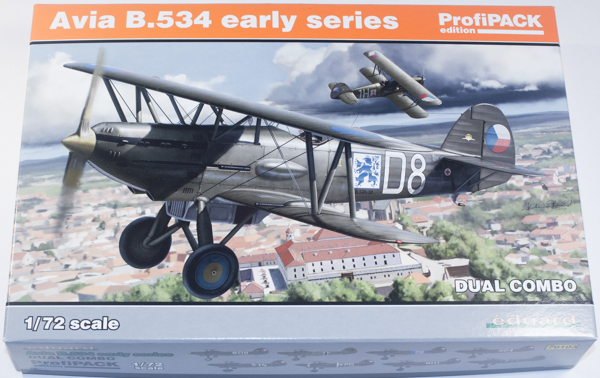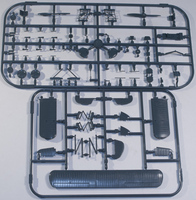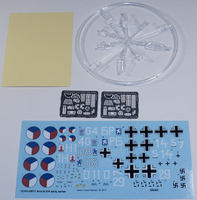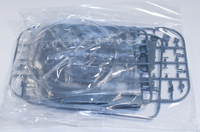
Eduard 1/72 Avia B.534 Early Series
By Matt Bittner
Introduction
From Eduard's instructions:
"The Avia B.534 was developed in 1934 as an extension of the B.34 fighter. In this incarnation, which was produced in small numbers for the Czechoslovak Air Force (the majority of which were attached to No.3 Fighter Regiment in Slovakia at the beginning of the Second World War), there were several engine/airframe combinations tried. The B.234 prototype served as the basis for the re-engined (Hispano Suiza 12 Ydrs for the original Avia R-29 radial) type that became the true B.534. This was the 1934 victor in a tender for a new standard fighter for the air force, and in June of that year, Avia received an order for an initial 34 aircraft. The orders accumulated to a total of 568 units, built in several production blocks.
"Assessments of the aircraft are somewhat variable. At the time of its development, it was an aircraft that was technically sound and utilized progressive construction techniques, but by the time of the Munich Crisis, the technology was slowly but surely entering the realm of the obsolete. To top it off, the politics of the situation during the Crisis disallowed the chance of combat. The chance for combat missions to be flown didn't occur until a few years later, in 1941, in the services of the Slovak State, fighting for the side that had previously been the aggressor against which they were to stand. Slovak pilots flying the B.534 on the Eastern Front gained good results, and these can be viewed upon as being the climax of the career of the type. A year later, it was apparent that replacement by more modern types was necessary, and inevitable. Bulgarian attempts to combat Ploesti raiding B-24 Liberators with the B.534 was a failure, and the aging planes were not able to climb to the Liberator's operational altitudes. In Slovakia, as in Bulgaria, the type was destined for second line relegation.
"Some of the remaining B.534s were destined for final operations within the Bulgarian Air Force in operations over Hungary in 1944, and with Slovakia during the several weeks long uprising against Germany (late August early November 1944). During the Slovak National Uprising, the type was used primarily in the ground attack role, and one did manage a kill to become what is the last aerial victory of a biplane in history. It should be noted that the kill in question was that of a Hungarian transport. The fact remains that the Slovak National Uprising did end up being the swansong of the Avia B.534. Certainly, it can be said that due to the era and climate of the service of this aircraft, and the length of service it was able to achieve, the Avia B.534 has become one of the most profound symbols of Czechoslovak aviation history, a very positive symbol.
"With this kit, we are introducing the Avia B.534 in its I and II variant. The B.534 Serie I was built to the tune of 100 units (Construction Numbers 2 to 101). They were armed with a pair of vz. 30 (Version 30) machine guns in the sides of the fuselage, and another gun on each wing in small aerodynamic gondolas. These were, however, soon removed at Avia, and from the 48th aircraft, only the fuselage guns were mounted. The first aircraft were accepted by the Czechoslovak Air Force in the fall of 1935. Aircraft of the second series (Construction Numbers 102 to 147) differed in their gun arrangement. The fuselage guns were doubled, from one to two on each side, and so the B.534 Series II was characterised by having four vz.30 gun armament. This required an increase in the size of the fairing covering the guns. These aircraft were accepted by the Air Force in April 1936. Due to the rising tensions with Germany, priority was given to equipping Air Regiment 1 and 4 in Bohemia, and later were allocated to units eastward, in Moravia and Slovakia."
The Kit
The Eduard 1/72 Avia B.534 Early Series kit Dual Combo ProfiPACK (#70103) consists of two complete B.534s. The entire boxing consists of 73 pieces of gray, injected plastic (this count is just the parts used for this boxing: you will have left over parts because the common sprue (K) contains parts for all Eduard B.534 releases); two, clear, injected windscreens (again, you will have left over clear parts); and two photoetch frets with a total of 44 parts between them. Decals are for seven, early B.534s (all green/khaki uppers with aluminum undersides):
- B.534.31 I. serie, 34th Fighter Squadron, Air Regiment 4, Hradec Kralove, July 1937
- B.534.47 I. serie, 34th Fighrer Squadron, Air Regiment 4, Hradec Kralove, September 1936
- B.534.49 I. serie, 36th Fighter Squadron, Air Regiment 2, Olomouc, June 1937
- B.534 I. serie, Jagdfliegerschule 4, Luftwaffe, Fu(umlaut)rth, German, 1940
- B.534.102 II. Serie, 31st Fighter Squadron, Air Regiment 1, Hradec Kralove, May 1938
- B.534.139 II. Serie, Aerospace Research and Test Establishment, Prague, 1936
- B.534.141 II. Serie, 38th Fighter Squadron, Air Regiment 3, Vajnory, August 1937
- B.534.129 II. Serie, Jagdfliegerschule 4, Luftwaffe Fu(umlaut)rth, Germany, 1940
Decals are typical Eduard quality, nicely printed and in register and includes stenciling. Also included in the box are two frets of photoetch (one for each kit, and mainly with pieces for the cockpit) along with masks. Note that instruction steps are broken up based on the two different types, I. serie and II. serie.

|
If you want to see what an Eduard B.534 looks like built-up, check out my full build of a III. serie machine.
Like all of their B.534s construction starts with the cockpit and it's pretty complete with just the plastic pieces; adding the photoetch parts will make it that much better. Once the cockpit is constructed then add it after adding all the other details to the fuselage, including the sidewalls, gun-butts and the intake and exhaust pieces of the radiator. After all those pieces are added then the fuselage halves are glued together, followed by adding the tail surfaces (minus the rudder) and the upper, forward fuselage with the instrument panel.
Now the lower wings are added along with the wing-guns if building a very-early I. serie machine (basically the very first aircraft in the marking information above). While this instruction step also has you add the upper wing and struts, definitely leave these off until after painting.

|
There are items in the next instruction steps I would leave off until after painting, to include the main landing gear, tail skid and horizontal tail struts,. I would add the radiator straps and door so those are painted the same time as that section of the model.
Thankfully with this release Eduard has provided not only the masks for the underside of the stabs (the upper-side green wrapped around the edges) but also includes masks for the wing tips. Something left off their separate masks for the earlier III. and IV. serie kits.

|
Another interesting aspect with this release of the B.534 series is Eduard completely re-molded the wings. They look a lot better and were also released as separate Overtrees if you want to replace any you have from prior kits (I leave it up to you to decide that).
Conclusion
Another excellent release in Eduard's 1/72 Avia B.534 series. These are superlative kits and look great when built.
My thanks to Eduard for the review Dual Combo.
